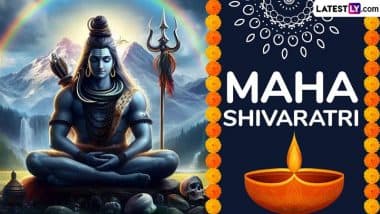Maha Shivaratri is a monumental festival that celebrates the divine union of Lord Shiva and Goddess Shakti. This night, which falls on the Chaturdashi Tithi during the Krishna Paksha of the Magha month, holds deep spiritual significance. In South India, this festival is observed according to the South Indian calendar, while in North India, it corresponds to the Masik Shivaratri of the Phalguna month. Despite differences in naming conventions based on regional lunar calendars, devotees across India celebrate Maha Shivaratri on the same day. So, when is Maha Shivratri 2025? Below, find the Maha Shivratri 2025 date, shubh mhurat, rituals, legends and significance to celebrate the Great Night of Shiva. Hindu Festivals Calendar 2025: Know the Dates of Holi, Chaitra Navratri, Durga Puja, Ganesh Chaturthi, Diwali and Other Major Festivals in India.
Maha Shivaratri 2025 Date and Shubh Muhurat
In 2025, Maha Shivaratri will be celebrated on Wednesday, February 26, with the Nishita Kaal Puja occurring from 12:09 AM to 12:59 AM on February 27. The duration of this ritual is 50 minutes, marking an auspicious period for worship and devotion.
Maha Shivaratri Legends and Significance
Maha Shivaratri is steeped in numerous legends and stories, especially as recounted in texts like the Linga Purana. These ancient scriptures underline the importance of observing a fast and paying homage to Lord Shiva, particularly through worship of his iconic symbol, the Shiva Lingam. According to one legend, this night is when Lord Shiva performed his cosmic dance, the Tandava, which signifies the eternal cycle of creation, preservation, and destruction. Purnima 2025 Calendar: Know Full Moon Dates, Poornima Significance and Fasting Rituals for the Auspicious Observance.
Another popular myth tells of the marriage of Lord Shiva and Goddess Parvati, which is believed to have occurred on Maha Shivaratri. This makes the festival especially meaningful for married couples and women seeking a prosperous union.
Maha Shivaratri Rituals
The celebration of Maha Shivaratri begins early in the morning, as devotees wake up before sunrise to take a bath, don new clothes, and prepare for the day’s rituals. The Maha Shivaratri Puja involves various offerings and rituals, with women playing a crucial role in the ceremonies. Devotees offer water, milk, Bel leaves, and fruits like Ber (jujube), and burn incense sticks while performing circumambulations around the Shiva Lingam—either three or seven rounds. This act symbolizes devotion and respect for Lord Shiva.
The Maha Shivaratri Puja is structured around six essential offerings, each carrying a deep spiritual meaning:
- Water and Milk Bathing the Shiva Lingam: This purifies the soul.
- Vermilion Application: Symbolising virtue and purity.
- Offering Fruits: Representing the fulfilment of desires and the wish for longevity.
- Burning Incense Sticks: Emblematic of the acquisition of wealth and prosperity.
- Betel Leaves: Signifying contentment and the satisfaction of worldly desires.
- Lighting Lamps: Symbolising the attainment of wisdom and enlightenment.
Maha Shivaratri is not just a celebration but a profound spiritual experience that draws devotees closer to the divine presence of Lord Shiva. Whether through fasting, chanting, or performing sacred rituals, the night signifies devotion, purity, and the worship of the supreme god who represents the ultimate truth.
(Disclaimer: The information provided here is based on beliefs and legends only. Before applying any information in real life, consult the concerned expert.)
(The above story first appeared on LatestLY on Feb 17, 2025 10:20 AM IST. For more news and updates on politics, world, sports, entertainment and lifestyle, log on to our website latestly.com).













 Quickly
Quickly




















